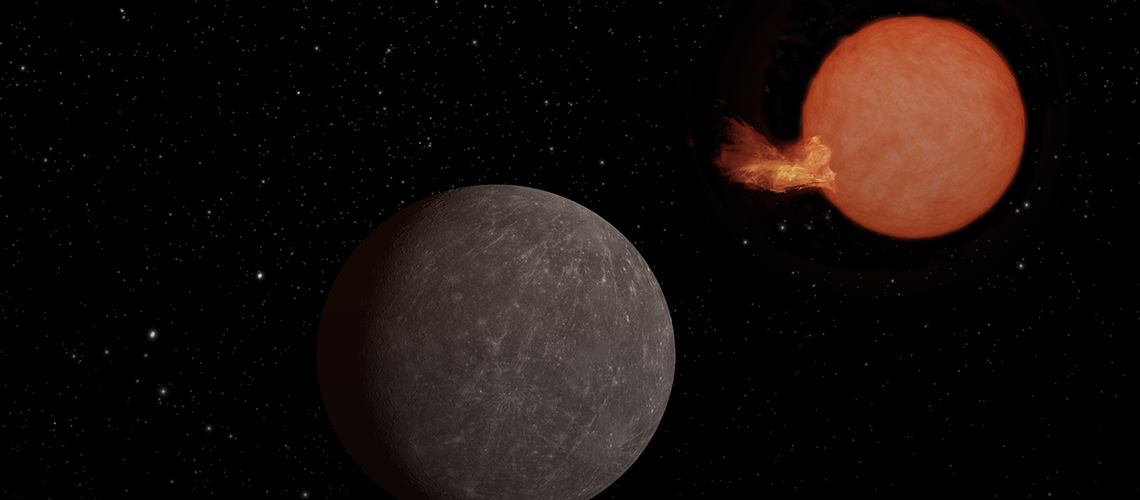Follow us on Google News (click on ☆)

Artist's concept of the exoplanet SPECULOOS-3 b orbiting its ultra-cool red dwarf star. The planet is as large as Earth, while its star is slightly larger than Jupiter but much more massive.
Credit: NASA/JPL-Caltech
This is only the second time that scientists— including members of the NCCR PlanetS, the University of Geneva (UNIGE), and the University of Bern (UNIBE)—have discovered an Earth-sized exoplanet (SPECULOOS-3 b) around an ultra-cool red dwarf star. Red dwarfs constitute 70% of the stars in our galaxy. The small size and lower luminosity of these stars facilitate the analysis of any orbiting planets. These planetary systems particularly interest astronomers working on the questions of life in the Universe, especially those from the Center for Life in the Universe at UNIGE. The discovery of SPECULOOS-3 b is published today in the journal Nature Astronomy.
The exoplanet SPECULOOS-3 b is located about 55 light-years from Earth (relatively nearby) and is almost the same size as our blue planet. However, the similarities end there since the new arrival orbits its star in only 17 hours, and days and nights may never end. The planet is likely tidally locked, meaning the same side, called the day side, always faces the star, much like the Moon does with Earth. The night side, on the other hand, would be in perpetual darkness.
Despite these "few" differences with our Earth, this type of planet particularly interests astronomers, especially those at the Center for Life in the Universe (CVU). "SPECULOOS-3 b is orbiting a red dwarf star," confirms Émeline Bolmont, assistant professor in the Department of Astronomy at UNIGE, director of the CVU, and co-author of the study. "The small size of these stars facilitates the detection of small Earth-sized planets around them and, especially, the observation of potential planetary atmospheres. Numerous studies show that life could develop on planets orbiting red dwarfs. They are thus ideal candidates for us."
Countless red dwarfs around us
More than 70% of the stars in the Milky Way are M dwarfs, also called red dwarfs. These stars are cooler and dimmer compared to our Sun but have much longer lifespans. Stars like our Sun burn for about 10 billion years before turning into red giants that consume any close planets. M dwarfs burn for 100 billion years or more, possibly providing an anchor point for life and an even longer window for its development.
With an average temperature of around 4,700 °F (2,600 °C), the star SPECULOOS-3 is several thousand degrees cooler than our Sun (10,000 °F or 5,500 °C). Detecting such a star—let alone a planet orbiting it—is an achievement in itself, as it is over a thousand times less luminous than the Sun. SPECULOOS-3 belongs to the subclass of ultra-cool stars, the darkest and most enduring ones. When the universe becomes cold and dark, these stars will be the last to burn.
The SPECULOOS project
Since these ultra-cool stars are very dim, their planetary population remains largely unexplored. The SPECULOOS project (Search for Planets EClipsing ULtra-cOOl Stars), led by Michael Gillon of the University of Liège, Belgium, was designed to change this. Ultra-cool dwarf stars are scattered across the sky, requiring individual observation for weeks to have a good chance of detecting transiting planets. This demands a dedicated network of professional telescopes, which is the concept of SPECULOOS.
Among the telescopes in this network, the robotic telescope SAINT-EX was partly funded by the Universities of Geneva and Bern, the two host institutions of the National Centre of Competence in Research (NCCR) PlanetS, which also provided financial support for the project. Besides SAINT-EX, SPECULOOS has partnerships with the universities of Cambridge, Birmingham, the Massachusetts Institute of Technology (MIT), and ETH Zurich.
An exo-Earth?
Due to its very short orbit, the planet SPECULOOS-3 b receives about 16 times more energy per second from its star than Earth gets from the Sun. It is literally bombarded with high-energy radiation. The planet thus does not lie in the habitable zone (where liquid water can exist on the surface of a planet) of its star, unlike some planets of another ultra-cool red dwarf, TRAPPIST-1, discovered in 2015 by the TRAPPIST telescope.
Although too close to its star to have liquid water, SPECULOOS-3 b remains intriguing for astronomers. "This planet is an ideal target for the James Webb Space Telescope (JWST), even better than the planets of TRAPPIST-1," confirms Émeline Bolmont. "The JWST should be able to determine if the planet has managed to retain an atmosphere despite the proximity to its star. If an atmosphere is found on this highly irradiated planet, it gives hope that atmospheres might also exist on the habitable zone planets of TRAPPIST-1."